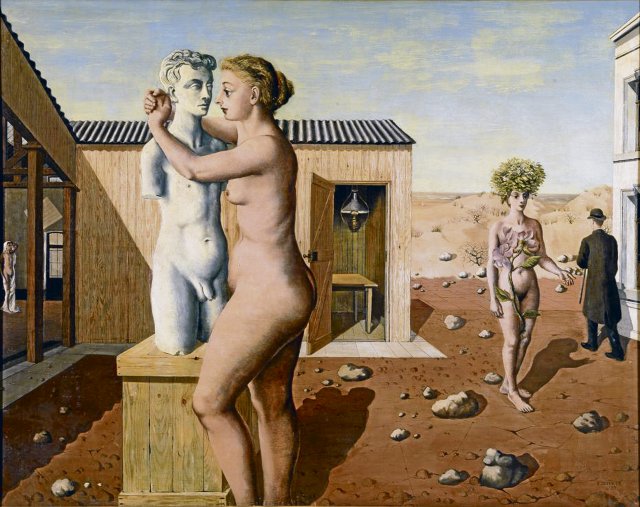Embarrassed banished to a separate room? Paul Delvaux, »Pygmalion«, 1939
Photo: © Foundation Paul Delvaux, Sint-Idesbald – Sabam Belgium
In his 1926 work “Paysan de Paris” (Parisian Country Life), Louis Aragon evoked Café Certá as the birthplace of surrealism: “(How) easy it is to fall into dreaming here, in this enviable peace. It comes into being all by itself. This is where surrealism comes into its own. They bring you a glass inkstand stopped with a champagne cork and you’re in full swing. Images trickle down like confetti. Pictures, pictures, pictures everywhere. (…) But if I (…) lift the curtains of the panes a little, then I am captivated by the spectacle of the passage, the comings and goings, the passers-by. (…) There are as many gaits as there are clouds in the sky.” Walter Benjamin alluded to the meetings of André Breton and other later Surrealists in the Café Certá, which Aragon also initiated, when he wrote: “The father of Surrealism was Dada, his Mother was a passage.”
The surrealist movement came from literature and was a consequence of the decline of the major forms of bourgeois literature. Aragon’s essay “Une vague de rêves” (A Dream Wave), published in 1924, is considered a surrealist manifesto even before André Breton’s “First Manifesto of Surrealism.” In 1922 he announced his final break with Dadaism in the magazine “Littérature” and ended his text with a call to take to the streets. The Belgian surrealist and co-founder of the Belgian Communist Party, Paul Nougé, wrote in 1924: “Art is demobilized, it is about living.” A year later he spoke of the need for the development of the social revolution and signed the pamphlet “La Révolution d ‘abord et toujours!’, in which the Paris Surrealists denounced France’s colonial war in Morocco.
The bourgeoisie’s hostility to any expression of radical intellectual freedom pushed surrealism to the left. Political events, especially the Moroccan War, accelerated this development. At the end of 1926, René Magritte, who radically changed his painting style after seeing Giorgio de Chirico’s painting “Chant d’amour” (1914), and ELT Mesens joined the group around Nougé, who had already done so from 1924 with Marcel Lecomte and Camille Goemans published the periodical “Correspondance”. In his essay “Surrealism – The Last Snapshot of the European Intelligentsia” (1929), Benjamin wrote: “Since Bakunin there has not been a radical concept of freedom in Europe. The surrealists have it. They are the first to destroy the liberal, morally and humanistically calcified ideal of freedom…”
The chronological exhibition “Histoire de ne pas rire – Le Surréalisme en Belgique” is currently on view at the Bozar – Palais des Beaux-Arts in Brussels. In addition to paintings, photos, sculptures and drawings, it also includes manifestos, pamphlets and other printed matter from three Surrealists -generations. Belgian surrealism was, at its core, a male event. Magritte, who is omnipresent in the exhibition with his paintings, once noted: “The ‘surrealist woman’ was just as stupid an invention as the ‘pin-up girl’ that she is replacing today.” Works by Rachel Baes are presented announced that she was not a surrealist painter, but a surrealist who paints. Her painted world is one of little girls and refers to childhood trauma. Jane Graverol, the driving force of the Surrealist movement in Belgium according to art historian Marie Godet, described her paintings as “conscious dreams.” A recurring motif is the cage in which sometimes a woman, sometimes an angel and sometimes the entire globe is locked up.
Paul Nougé’s dream worlds in his 13-part black and white photo series “Subversions des images”, which were taken in 1929/30 but were not published until 1968, deserve special mention. Raoul Ubac staged unusually shaped stones from Dalmatia as surrealistic objects and experimented with double exposure, photograms and other techniques. Marcel Lefrancq photographed Mons at night in 1938. Night was the most romantic theme of the Surrealists, and Novalis had already formulated that it was the key to understanding reality and the “infinite secrets of silent messengers.” The painting “Nocturnes” by Paul Delvaux, like his other paintings, is populated by naked women making strange hand movements. ELT Mesens enriched the Belgian art world with his collages and photomontages. Marcel Mariën was seventeen years old when he joined the Belgian Surrealist group in 1937. His blasphemous 16mm film “L’imitation du cinéma” (1959), about a man who resembles Christ and wants to be nailed to the cross like him, is another highlight of the exhibition.
Although it appears in this catalog and even more so in the catalog that the Surrealists like Karl Marx wanted to transform the world and change lives like Arthur Rimbaud, the catalog also attests that they were a paradox: petty bourgeois who turned into revolutionaries in the service of the community.
The Musées Royaux des Beaux-Arts de Belgique probably borrowed the title of their surrealism show “Imagine!” from John Lennon, without, however, referring to its content, the dream of a world without national borders, possessions, greed, hunger and war. Although the gender balance in this exhibition is better than in the neighboring Bozar, the rebellious nature of avant-garde art is not related to the social forces of revolt. A wall text simply reads: “As in a bad dream, the feverish visions of the 1930s, full of horror, show the atrocities that fascism, Nazism and Stalinism would commit.” Surrealism here means a connection to symbolism and thematic settings , such as night, forest, forest spirits, chimeras, etc. Surrealist art practice was driven by erotic energies, but here the erotic works are quite bashfully banished to a separate room. And instead of imagining what could have become of the joint revolutionary-surrealist practice initiated between Leon Trotsky and André Breton at the foot of the Mexican volcanoes Popocatépetl and Iztaccihuatl, quite a lot of space is given to the obsessed showman and fascism-sympathizing Salvador Dalí.
»A History of Not Laughing – Surrealism in Belgium«, twice on 16. Juni, Bozar, Brüssel and »Imagine! 100 Years of International Surrealism«, bis zum 21. Juli, Royal Museums of Fine Arts of Belgium, Brüssel (danach in Paris, Hamburg, Madrid and Philadelphia)
Subscribe to the “nd”

Being left is complicated.
We keep track!
With our digital promotional subscription you can read all issues of »nd« digitally (nd.App or nd.Epaper) for little money at home or on the go.
Subscribe now!
sbobet88 sbobet sbobet88 sbobet
